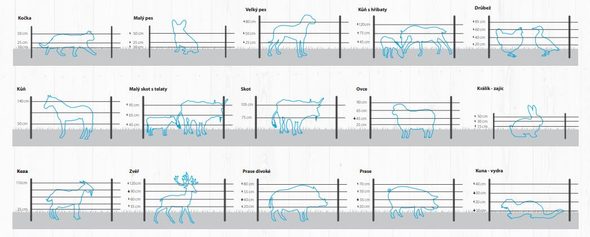Displaying 8 products - filter the results to match your requirements.
We are showing 1-8 out of 8 products
| 1|
An electronic fence consists of an electric generator and a fence defined by posts and wires. The electric generator supplies the fence lines with current pulses. These pulses are characterised by high voltage and very short duration. The electric shock is very unpleasant and the animals quickly learn to respect the fence. The electric fence is not only a physical but also a psychological obstacle.
An electric fence consists of an electric generator and a fence defined by posts and wires. The electric generator supplies the fence lines with current pulses. These pulses are characterised by high voltage and very short duration. The electric shock is very unpleasant and the animals quickly learn to respect the fence. The electric fence is not only a physical but also a psychological obstacle.

The earthing is used to close the loop in the event of the animal touching the conductor. It is important that the connection between the ground rod and the source itself is perfectly conductive. Galvanized ground rods are suitable for grounding the generator of an electric fence. A well-designed earthing is the basis for a reliably functioning fence. The rods are available in different lengths.
Testers are used to measure the current voltage on the fence. You can use the tester to find, for example, a badly connected connection - you can measure a higher voltage in front of the node than behind it. There should be a minimum voltage of 3000 V at each point of the fence, which is necessary to overcome the skin resistance. If 5 - 7 000 V is measured, the fence is fine. Voltages above 9 000 V can cause the plastic wires to burn through.
For electric fencing, it is used to separate the live conductor from the poles. The insulator should be chosen according to which conductor it is intended for (wire, wire, rope, tape) and where it will be in the fence. Continuous insulators are used on straight sections, corner and tension insulators are installed at breaks and corners, and insulators that can be hung with a handle are installed at entrances.
The wire is an essential part of the electric fence - mesh, ropes, nets, tape or wire. An important consideration for electric fence wires is their conductivity and mechanical strength. Electric fence wires are also available in various colours and colour combinations. The type and quality of wire is determined by the type and category of grazing animal, the size of the pasture, the terrain configuration and whether it is permanent or temporary. The height should be chosen according to the size of the animals kept. The wires on the paddock can be a combination, rope and tape or wire and tape.
The ropes are made of polyethylene, have high strength and are used for smaller fences, they are relatively heavy and the stakes need to be closer together.
The tapes are made of polyethylene fibers. It is suitable for longer fences such as horse grazing. You can get the tape in several widths, 1 to 4 cm.
The wires and steel cables have relatively low resistance. They are mainly used for permanent fences because they are very difficult to twist. The disadvantage is low visibility - poor visibility.
Couplings are used for electric fencing as wire connections. It is a good idea to connect the individual wires on the fence to each other. A poor quality connection with only a knot leads to transient resistance. For wire or wire rope, pieces of copper wire can be used for splicing, for wide strips it is better to use the original jumper cable.
The entrances are for grazing access, the same material should be used at the entrance as on the rest of the paddock. If rope or tape is used as a wire on the corral, a separate handle is sufficient. If hard wire is used, entrance springs are preferable. Solid metal gates can also be installed and locked.
To warn passers-by, fencing is supplemented with warning signs to be placed where movement of people can be expected. In particular, entrances or fenced-off paths where people were used to driving or walking should be highlighted.
Electric fences are designed primarily for livestock breeding - cattle, sheep, goats, horses. Nowadays, fences are also used to secure areas where dogs are kept. Electric fences can also be used to protect crops from wild animals. They can also be used to protect water bodies from visiting otters and to protect monuments from birds. As a supplement to fencing, electric fencing is also used in the keeping of exotic animals in zoos.

Displaying 8 products - filter the results to match your requirements.
We are showing 1-8 out of 8 products